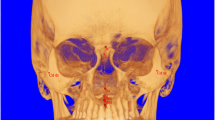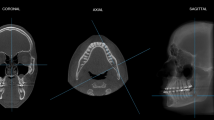Abstract
Objective
As most orthognathic surgeries focus on the lower face, the aim of this study was to transfer previously developed two-dimensional cephalometry—which is useful for surgeons in the orthognathic surgery of the lower face—to three-dimensional (3D) cephalometry by using cone-beam computed tomography (CBCT). We selected the quadrilateral lower face analysis developed by the surgeon Di Paolo, who focused only for the lower face and mentioned that data in millimeters are more easy to use than angles for surgeons. Additionally, we wanted to create a 3D lower face analysis approach based on quadrilateral analysis and establish a reference table for surgical planning.
Study design
Three investigators assigned 16 landmarks on CBCT images from 30 patients with normocclusion. Intra-class correlation coefficients (ICCs) and standard deviations (SDs) were calculated according to each landmark. The maxillary and mandibular lengths and widths and the anterior and posterior lower facial heights (ALFH and PLFH) are presented as means and SDs. The asymmetry of the face was calculated with paired t test, and the coherence of the lower face was assessed with correlation coefficients (r) and regression models.
Results
The ICCs were ≥0.90, and the SDs of the landmarks were lower than 1.00 mm, except for the J-point, which was located at the junction of the anterior border of the ramus and the corpus of the mandible. The SDs of linear measurements were 3.06–5.20 mm, and there was no significant facial asymmetry. The r among the structures was greater than 0.3 in 13 of 15 assessments. Based on these values, we could establish a floating norm of the lower face using the following five regressions: one linear regression for the mandibular length, two quadratic models for the ALFH and PLFH, and two multivariate regressions for the posterior widths of the maxillae and mandible.
Conclusion
The adaptation of quadrilateral analysis can provide accurate 3D characterization of the morphology of the lower face and the floating norm based on millimeter values, which is practical for surgeons. As the 3D extension of quadrilateral analysis could provide references of the lower face, which might be an accurate 3D approach for presurgical planning, the further investigation in bigger sample would be relevant in the practice.









Similar content being viewed by others
References
Papadopoulos MA, Jannowitz C, Boettcher P, Henke J, Stolla R, Zeilhofer HF, Kovacs L, Erhardt W, Biemer E, Papadopulos NA (2005) Three-dimensional fetal cephalometry: an evaluation of the reliability of cephalometric measurements based on three-dimensional CT reconstructions and on dry skulls of sheep fetuses. Journal of Cranio-Maxillo-Facial Surgery: Official Publication of the European Association for Cranio-Maxillo-Facial Surgery 33(4):229–237. doi:10.1016/j.jcms.2005.02.003
Sicurezza E, Greco M, Giordano D, Maiorana F, Leonardi R (2012) Accuracy of landmark identification on postero-anterior cephalograms. Prog Orthod 13(2):132–140. doi:10.1016/j.pio.2011.10.003
Silva MA, Wolf U, Heinicke F, Bumann A, Visser H, Hirsch E (2008) Cone-beam computed tomography for routine orthodontic treatment planning: a radiation dose evaluation. American Journal of Orthodontics and Dentofacial Orthopedics: Official Publication of the American Association of Orthodontists, its constituent societies, and the American Board of Orthodontics 133(5):640.e641–640.e645. doi:10.1016/j.ajodo.2007.11.019
Chau AC, Fung K (2009) Comparison of radiation dose for implant imaging using conventional spiral tomography, computed tomography, and cone-beam computed tomography. Oral Surgery, Oral Medicine, Oral Pathology, Oral Radiology, and Endodontics 107(4):559–565. doi:10.1016/j.tripleo.2008.11.009
De Vos W, Casselman J, Swennen GR (2009) Cone-beam computerized tomography (CBCT) imaging of the oral and maxillofacial region: a systematic review of the literature. Int J Oral Maxillofac Surg 38(6):609–625. doi:10.1016/j.ijom.2009.02.028
Zamora N, Llamas JM, Cibrian R, Gandia JL, Paredes V (2012) A study on the reproducibility of cephalometric landmarks when undertaking a three-dimensional (3D) cephalometric analysis. Medicina oral, patologia oral y cirugia bucal 17(4):e678–e688
Kim S (2010) Cone beam computed tomography (CBCT) dosimetry: measurements and Monte Carlo simulations. Dissertation, Duke University
Cattaneo PM, Melsen B (2008) The use of cone-beam computed tomography in an orthodontic department in between research and daily clinic. World Journal of Orthodontics 9(3):269–282
Gribel BF, Gribel MN, Frazao DC, McNamara JA Jr, Manzi FR (2011a) Accuracy and reliability of craniometric measurements on lateral cephalometry and 3D measurements on CBCT scans. The Angle Orthodontist 81(1):26–35. doi:10.2319/032210-166.1
Pittayapat P, Bornstein MM, Imada TS, Coucke W, Lambrichts I, Jacobs R (2015) Accuracy of linear measurements using three imaging modalities: two lateral cephalograms and one 3D model from CBCT data. Eur J Orthod 37:202–208. doi:10.1093/ejo/cju036
Gribel BF, Gribel MN, Manzi FR, Brooks SL, McNamara JA Jr (2011b) From 2D to 3D: an algorithm to derive normal values for 3-dimensional computerized assessment. The Angle Orthodontist 81(1):3–10. doi:10.2319/032910-173.1
Di Paolo RJ, Philip C, Maganzini AL, Hirce JD (1984) The quadrilateral analysis: a differential diagnosis for surgical orthodontics. Am J Orthod 86(6):470–482
Di Paolo RJPC, Maganzini AL, Hirce JD (1983) The quadrilateral analysis: an individualized skeletal assessment. Am J Orthod 83(1):19–32
Lou L, Lagravere MO, Compton S, Major PW, Flores-Mir C (2007) Accuracy of measurements and reliability of landmark identification with computed tomography (CT) techniques in the maxillofacial area: a systematic review. Oral Surgery, Oral Medicine, Oral Pathology, Oral Radiology, and Endodontics 104(3):402–411. doi:10.1016/j.tripleo.2006.07.015
Segner D, Hasund A (1998) Individualisierte Kephalometrie, 3rd edn. Dietmar Segner Verlag, Hamburg
Di Paolo RJ (1970) Cephalometric diagnosis using the quadrilateral analysis. J Clin Orthod 4:30–35
Di Paolo RJ (1969) The quadrilateral analysis: cephalometric analysis of the lower face. J Clin Orthod 3(10):523–530
Lagravere MO, Low C, Flores-Mir C, Chung R, Carey JP, Heo G, Major PW (2010) Intraexaminer and interexaminer reliabilities of landmark identification on digitized lateral cephalograms and formatted 3-dimensional cone-beam computerized tomography images. American Journal of Orthodontics and Dentofacial Orthopedics: Official Publication of the American Association of Orthodontists, its constituent societies, and the American Board of Orthodontics 137(5):598–604. doi:10.1016/j.ajodo.2008.07.018
Weinberg H, Kronman JH (1966) Orthodontic influence upon anterior facial height. The Angle Orthodontist 36(1):80–88. doi:10.1043/0003-3219(1966)036<0080:oiuafh>2.0.co;2
Scheideman GB, Bell WH, Legan HL, Finn RA, Reisch JS (1980) Cephalometric analysis of dentofacial normals. Am J Orthod 78(4):404–420
Bayome M, Park JH, Kook YA (2013) New three-dimensional cephalometric analyses among adults with a skeletal class I pattern and normal occlusion. Korean Journal of Orthodontics 43(2):62–73. doi:10.4041/kjod.2013.43.2.62
Wang MF, Otsuka T, Akimoto S, Sato S (2013) Vertical facial height and its correlation with facial width and depth: three dimensional cone beam computed tomography evaluation based on dry skulls. International Journal of Stomatology & Occlusion Medicine 6:120–129. doi:10.1007/s12548-013-0089-4
Severt TR, Proffit WR (1997) The prevalence of facial asymmetry in the dentofacial deformities population at the University of North Carolina. The International Journal of Adult Orthodontics and Orthognathic Surgery 12(3):171–176
Samman N, Tong AC, Cheung DL, Tideman H (1992) Analysis of 300 dentofacial deformities in Hong Kong. The International Journal of Adult Orthodontics and Orthognathic Surgery 7(3):181–185
de Moraes ME, Hollender LG, Chen CS, Moraes LC, Balducci I (2011) Evaluating craniofacial asymmetry with digital cephalometric images and cone-beam computed tomography. American Journal of Orthodontics and Dentofacial Orthopedics: Official Publication of the American Association of Orthodontists, its constituent societies, and the American Board of Orthodontics 139(6):e523–e531. doi:10.1016/j.ajodo.2010.10.020
Farkas LG, Cheung G (1981) Facial asymmetry in healthy North American Caucasians: an anthropometrical study. Angle Orthod 51(1):70–77
Levine M, Ensom MH (2001) Post hoc power analysis: an idea whose time has passed? Pharmacotherapy 21(4):405–409
Hoenig JM, Heisey DM (2001) The abuse of power: the pervasive fallacy of power calculations for data analysis. Am Stat 55(1):19–24
Lundstrom F, Leighton BC, Richardson A, Lundstrom A (1998) A proportional analysis of some facial height and depth variables in 10 to 16 year old children. Eur J Orthod 20(1):35–44
Franchi L, Baccetti T, McNamara JA Jr (1998) Cephalometric floating norms for North American adults. The Angle Orthodontist 68(6):497–502. doi:10.1043/0003-3219(1998)068<0497:cfnfna>2.3.co;2
Bingmer M, Ozkan V, Jo JM, Lee KJ, Baik HS, Schneider G (2010) A new concept for the cephalometric evaluation of craniofacial patterns (multiharmony). Eur J Orthod 32(6):645–654. doi:10.1093/ejo/cjp152
Author information
Authors and Affiliations
Corresponding author
Ethics declarations
The study was approved by the ethics committee of our institution (approval number: TUKEB 2/2008).
Rights and permissions
About this article
Cite this article
Dobai, A., Vizkelety, T., Markella, Z. et al. Lower face cephalometry based on quadrilateral analysis with cone-beam computed tomography: a clinical pilot study. Oral Maxillofac Surg 21, 207–218 (2017). https://doi.org/10.1007/s10006-017-0620-7
Received:
Accepted:
Published:
Issue Date:
DOI: https://doi.org/10.1007/s10006-017-0620-7




